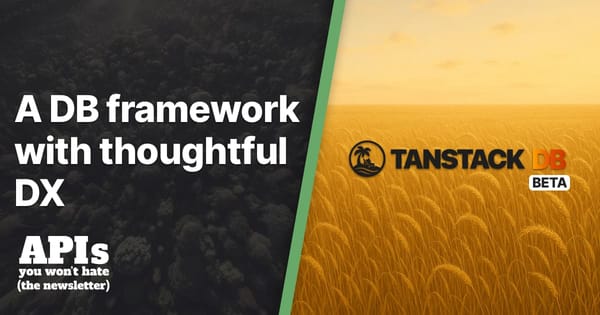Partials: Happy Compromise Between Customization and Cacheability

With endpoint-based APIs (REST, RESTish, SOAP, RPC, AJAX-ish junk, etc.) you get
to choose if you want increased likelihood of network cache hits, or the ability
to slim down the response. The two goals are mutually exclusive.
Slimming responses can be achieved with concepts like sparse
fieldsets
(tl:dr; send ?fields=foo,bar to just get foo and bar).
This is common and popular for two reasons:
- It takes fractionally less time to download a smaller response over the
network - Some of those fields might be computed on request, and as such are
slow
Specifications like OData and
JSON:API
support this, and most of their tooling also support it. The trouble is, the
more you allow a response to be customized, the lower the chance of a cache hit.
If two different clients (eg: the web app and the iOS app) request slightly
different fields, then they’re not shared, and the network cache is keeping one
set of caches for web and one for ios. That’s half as useful, and the more
different clients you have, the less useful network caching becomes (if you’re
using sparse fieldsets).
This is a massive shame! Varnish,
Squid, Fastly, etc.,
can all be a huge boost to the speed and stability of your architecture, and can
save a bunch of money by reducing your application server hosting resources.
For those using network caching, there are two common scenarios.
High Customization, Low Cache Hits
The Turtles.com web app requests GET /turtles?fields=name,lifespan which takes
200ms.
The Turtles.com iOS app then requests GET /turtles?fields=name which takes
192ms, because the network cache did not consider this request as a match for
the first request (and rightly so). Skipping the lifespan field made the JSON
serializer do a little less work, and the time in transit was reduced too, so we
saved a few ms.
No Customization, High Cache Hits
The Turtles.com web app GET /turtles which takes 220ms. That's a little slower
as we've got all the fields (maybe 20 of them) coming back.
The Turtles.com iOS app then requests GET /turtles the network cache considers
that a hit, and short circuits the application server entirely, responding in
118ms.
Even though the iOS app doesn’t need all the fields, we’ve hit the network
cache, and subsequent requests are matching.
This scenario is what most REST APIs do. It’s usually not an issue if fields are
all precomputed and simply being fetched, but this scenario really falls apart
when computed fields are part of the resource.
Computed Fields Suck
I’ve seen a simple "is_enterprise": true field snuck into a serializer, which
then makes 3-4 SQL queries to establish if the company should be considered
enterprise (if it has more than 500 members, going via a pivot table, etc).
It also had "locations" field, which is an array of data fetched from another
system. This API is a fairly slow responder on the best of days, and sometimes
it has bad days. Bad days maybe this endpoint takes 1-2s instead of the
118-220ms we've been discussing.
No amount of clever eager-loading or caching trickery can fully solve the fact
that multiple computed fields are going to slow down all/some responses,
especially when fetching a collection. Clients having their requests slowed down
by being handed expensive information (that they didn’t even want) is a
completely understandable source of frustration.
The obvious advice is "don’t have expensive computed fields in the resource",
and just pre-compute them, but sometimes these things are either unavoidable, or
somebody else did it and you don’t have time to fix everything all in one go.
Let’s accept them as an unfortunate reality and move on.
One solution is see often a new endpoint: GET /turtles/lean which doesn't
really help, and is occasionally a slippery slope to client and use-case
specific endpoints (GET /turtles/mobile, GET /turtles/ios, GET /turtles/ios-random-usecase-tuesday5. That's no ideal (cache missing all over
the shop and forces the team maintaining that API to know too much about
specific use cases). It also does not help us with collections.
Others do ?full=true and have a "Basic" and "Full" serializer for the same
response, which is a bit too binary to be considered customization. If you want
to call the collection and only need one or two fields from that full version,
you're stuck with all the fields, including whatever computed values are there
which you still don't want.
Reasonable Cache Hits, Partial Customization
One solution to make your endpoint-based API responses partially customizable
is… partials!
Google have been recommending this solution for years as a common best practice,
and YouTube was doing before that.
GET /turtles?partial=dimensions
Instead of specifying fields, we specify a partial, which is like a nickname for a group of fields.
Let’s stop talking about turtles for a minute, and go back to that company example. Here’s a simplified version of some code I wrote for WeWork:
class Api::V3::CompanyPresenter
attr_accessor :company, :partials
def initialize(company, partials: [])
[@company](https://twitter.com/company "Twitter profile for @company") = company
[@partials](https://twitter.com/partials "Twitter profile for @partials") = Array(partials)
end
def as_json
{
uuid: company.uuid,
name: company.name,
status: company.status,
}.tap do |hash|
hash[:locations] = locations if (partials & ['locations', 'full']).any?
hash[:enterprise] = company.enterprise? if (partials & ['enterprise', 'full']).any?
if (partials & ['contact_info', 'full']).any?
hash[:contact_info] = {
name: company.contact_name,
email: company.contact_email,
phone: company.contact_phone,
}
end
if partials.include? 'full'
# A bunch of other fields
end
end
end
def locations
ThirdPartyFooClient.fetch_slow_ass_data
end
end
Then in the collection controller I implement:
def index
companies = fetch_filtered_paginated_companies(params).map do |company|
Api::V3::CompanyPresenter.new(company, partials: whitelist_partials).as_json
end
render json: { companies: companies }
end
def show
company = find_company(params)
company = Api::V3::CompanyPresenter.new(company, partials: whitelist_partials).as_json
render json: { company: company }
end
def whitelist_partials
if params[:partials]
partials = Array(params[:include].split(','))
['contact_info', 'locations', 'enterprise', 'full'] & partials
end
end
Now calling GET /api/v3/companies will result in only uuid, name and
status being added, and if a client wants locations or any of the other
allowed fields they can call them.
The potential values will be advertised in OpenAPI documentation so people can
find them, as this API does not even come close to having any HATEOAS
descriptors or anything else. Yet.
This code and this exact approach is not meant to be an example of wonderfully
perfect API design.
- I don’t like versions in the URL and prefer evolution
- Locations should almost certainly be a sub-collection
- Using existing serializers instead of hacking my own would be better
- Using JSON:API, HAL or Siren would be more useful instead of this naked JSON
Personal preferences aside, I was able to implement this partial functionality
in one endpoint very quickly and easily without breaking anything, and without
rewriting the entire API. Sometimes you need partial solutions, and partial
customization with ?partials= is partial enough for me.
Further Steps
Maybe make two different whitelists, one for resources and another for
collections of resources. If your API has a high pagination limit (or no
pagination 😱) and you’re letting ?partial=full then you could be in for a
really bad time.
What About GraphQL
So, anyone reading this who’s been hearing a lot about GraphQL would think: REST
is dumb, GraphQL fixes all of this!
Well no. REST provides these trade-offs for you to consider, and GraphQL forces
your hand into the one option that it allows: high customization and no
network cachability.
As discussed in GraphQL vs REST:
Caching,
GraphQL does not work with existing HTTP endpoint-based network caching tools,
so the only client options fall on the client attempting to handle it with very
little insight, and cache invalidation/expires potentially being very different
in two different clients, or your data all has to be restructured to support
potentially any call, with any huge amount of nesting, and all of the
serialization
that comes with it.
REST suggests you to make targeted endpoints with a very specific goal in mind,
that handle the specific set of data in a performant way and offer a bunch of
caching metadata for network tools to leverage. This should not be seen as a
negative point, especially with HTTP/2 removing the issue of "multiple
handshakes = slow".





